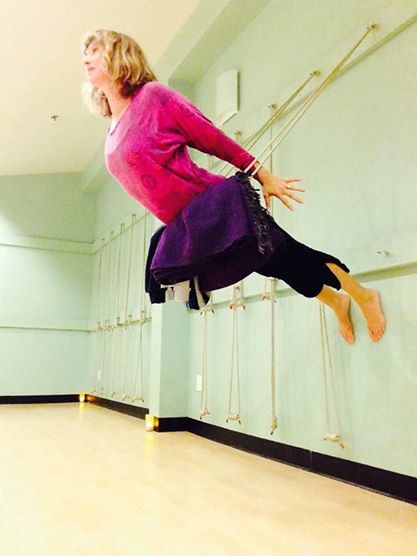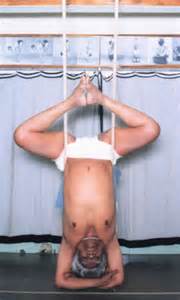Yoga Wall Ropes – Building Relationship with Receptivity and Support
Posted on
I was first properly introduced to wall ropes in a yoga class for back and neck care with Iyengar teacher Anne Saliou. At that point, I’d been teaching yoga for a number of years but a neck injury prevented me from practicing headstands and limited my back bending and arm balance practice. My injury and the chronic neck pain that went along with it was the result of a serious car crash in Afghanistan while visiting a remote desert village in the southern province of Kandahar. The driver was speeding on amorphous, sandy roads, skidded out of control and we rolled, a few times. After emerging from the the jeep and assessing the situation, we sat alongside the overturned vehicle with several of us facing potentially serious injuries. My Afghan colleague’s legs were pinned under the jeep and there was no one else in sight, just the vastness of the desert and the fading light of early evening. Attempts to radio for help were in vain and valiantly, but perhaps out of guilt too, the driver, who himself was injured, ran miles back to the village for help. There was no way I could have known at the time how this injury would in many ways illuminate my path and guide me toward teaching wall ropes, my Iyengar teacher and eventually studying with Noah Maze. What I did know while sitting in the silence of the desert, my fear eroding my hope, was that we were in Taliban territory and it was now dark; curfew had begun.
Everyone made it out of the desert ok that night thanks to our driver and an old beat up Russian Lada taxi he found in the village. My Afghan colleagues sustained the most severe but not permanently damaging injuries. The day after the accident I was flown back to Kabul in an International Red Cross single engine, six seater plane. We left the desert of Kandahar far behind and I marveled at the magnificence of the snow capped Hindu Kush mountains and the beauty of Afghanistan. A CT scan revealed that my injury was minor: compressed and misaligned vertebra that perhaps could have healed had I had the wealth of mind/body modalities that now surround me in San Francisco. But, I didn’t have the space in my mind or resources in my life, and the nature of post-conflict work is such that everyone else’s survival needs much outweighed my own.
Over a year later I was reintegrating into the US and I walked into Anne’s back and neck care yoga class in San Francisco feeling frustrated that my yoga knowledge wasn’t enough to heal my neck, and in many ways I was still living as if conflict was erupting all around me, not giving my body the time to heal and not allowing myself to receive much needed support. Anne taught me how to leverage the nuanced and not so nuanced feedback wall ropes give to create space in the upper back and neck, space where previously I only felt tension and pain. Alternately, I learned how to surrender to hanging backwards and upside down in ropes sirsasana (headstand) for traction to decompress my neck. Anne became my cherished teacher and I subsequently went on to assist her and teach her classes when she was out of town. The indelible lesson I took from hanging in the ropes during that time, healing an injury and my studies with Anne is what studentship really means; building a relationship born from trust and receptivity where growth thrives. I find yoga wall ropes to be the perfect metaphor for that relationship.
The same yoga studio where I learned the ropes went up in flames a few years later in a devastating fire from which it never recovered. I found myself lost without my yoga home, my students and my teacher. It was ironic that I’d finally experienced the profound learning that came from being vulnerable, receptive enough to have my mind and ass kicked with love and now somehow I had to tend to my yogic path without a teacher. Shortly after that while I considered continuing my teaching training accreditation, I came upon a video of Noah Maze talking about what it means to be a teacher and educator. The clarity, precision and cadence with which he spoke, spoke to me. I headed to Los Angeles within a month to begin 300 hour teacher training with him. Fast forward 9 years from when I first began this story and I now teach a wall ropes class twice a week at a Yoga Tree (Yoga Works) studio in San Francisco.
It was BKS Iyengar in Pune, India who invented and popularized yoga wall ropes or yoga “kurunta,” meaning puppet, as a way to support injuries, prepare the foundation of a pose and deepen awareness of alignment. The concept is really very simple; the wall ropes provide a straightforward combination of resistance and support encouraging the student to be held and use gravity and weight bearing to decompress joints, release tension and open the body where previously it might not have been possible. Geeta Iyengar, BKS Iyengar’s daughter and author of Yoga, A Gem for Women, has remarked that wall ropes teach students, “how to get space and quiet,” and to ultimately find freedom in the body.
The students who come to my classes range from beginners trying to figure out downward dog and build confidence in it to advanced students and yoga teachers who want to refine and deepen their study of asana. My wall ropes classes are potent and heat building in some moments as I ask students to stay present using the support of the ropes to refine alignment or balance and awaken more nuanced muscle groups in a pose like utthita parsvakonasana (extended side angle) or visvamitrasana. In other moments the class is cooling and I encourage students to fully surrender their weight to the ropes in calming inversions. Back bending with the ropes brings stability and precision to poses like urdhva mukha svanasana (upward dog) and urdhva dhanurasana (upward bow). Sometimes we even flow! But what I continually try to do is weave the themes of receptivity and support into the class and with the accountability that the ropes provide, the experience ultimately guides students back to themselves and self learning. From the feedback I get, students leave with a new perspective on their practice. And, while the tone and pace of the class is not therapeutic like the one in which I first learned the ropes, the alignment is. Adding wall ropes to your yoga studio will exponentially increase it’s value and your offerings to students. Installing them in your home or locating a wall ropes class will expand your practice.
These days there is a palpable richness to my life as I have two cherished teachers. Anne has just begun teaching at the Iyengar Institute of San Francisco and I have completed my 300 hour teacher training and begun the certification process which will take me to LA shortly to assist Noah. The same clarity and precision that spoke to me is now an integral component of my teaching style thanks to Noah, his team of talented teachers and an incredible peer group. Once again I feel that my journey is just beginning.
Gabby’s teaching style is primarily informed by years of study with Iyengar teachers and Noah Maze. She began teaching in 2000 and continues to be known as a teacher that creates a supportive class environment where challenging yoga and clear, precise instruction coalesce to foster growth and learning. She hold’s undergraduate degrees in Political Science and French and, after serving as a Peace Corps Volunteer in Mali, West Africa she returned to school and earned a Master’s degree in Conflict Resolution. While working in Kosovo and Afghanistan as a Consultant reintegrating refugees, she facilitated reconciliation and dialogue workshops with local leaders that integrated yoga as a healing tool. She now lives in San Francisco with her family and teaches Wall Ropes and Prenatal Yoga at the Yoga Tree.



